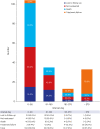Risk Factors for Unfavorable Outcomes of Tuberculosis in Korea: Implications for Patient-Centered Care in Tuberculosis Treatment
- PMID: 38225780
- PMCID: PMC10789522
- DOI: 10.3346/jkms.2024.39.e4
Risk Factors for Unfavorable Outcomes of Tuberculosis in Korea: Implications for Patient-Centered Care in Tuberculosis Treatment
Abstract
Background: The treatment success rate for tuberculosis (TB) has stagnated at 80-81% in South Korea, indicating unsatisfactory outcomes. Enhancing treatment success rate necessitates the development of individualized treatment approaches for each patient. This study aimed to identify the risk factors associated with unfavorable treatment outcomes to facilitate tailored TB care.
Methods: We retrospectively analyzed the data of patients with active TB between January 2019 and December 2020 at a single tertiary referral center. We classified unfavorable treatment outcomes according to the 2021 World Health Organization guidelines as follows: "lost to follow-up" (LTFU), "not evaluated" (NE), "death," and "treatment failure" (TF). Moreover, we analyzed risk factors for each unfavorable outcome using Cox proportional hazard regression analysis.
Results: A total of 659 patients (median age 62 years; male 54.3%) were included in the study. The total unfavorable outcomes were 28.1%: 4.6% LTFU, 9.6% NE, 9.1% deaths, and 4.9% TF. Multivariate analysis showed that a culture-confirmed diagnosis of TB was associated with a lower risk of LTFU (adjusted hazard ratio [aHR], 0.25; 95% confidence interval [CI], 0.10-0.63), whereas the occurrence of adverse drug reactions (ADRs) significantly increased the risk of LTFU (aHR, 6.63; 95% CI, 2.63-16.69). Patients living far from the hospital (aHR, 4.47; 95% CI, 2.50-7.97) and those with chronic kidney disease (aHR, 3.21; 95% CI, 1.33-7.75) were at higher risk of being transferred out to other health institutions (NE). Higher mortality was associated with older age (aHR, 1.06; 95% CI, 1.04-1.09) and comorbidities. The ADRs that occurred during TB treatment were a risk factor for TF (aHR, 6.88; 95% CI, 2.24-21.13).
Conclusion: Unfavorable outcomes of patients with TB were substantial at a tertiary referral center, and the risk factors for each unfavorable outcome varied. To improve treatment outcomes, close monitoring and the provision of tailored care for patients with TB are necessary.
Keywords: Lost to Follow-Up; Patient-Centered Care; Risk Factors; Tuberculosis.
© 2024 The Korean Academy of Medical Sciences.
Conflict of interest statement
The authors have no potential conflicts of interest to disclose.
Figures
Similar articles
-
Comparison of Patients Who Were Not Evaluated and Lost to Follow-Up with Multidrug/Rifampin-Resistant Tuberculosis in South Korea.Yonsei Med J. 2025 Jan;66(1):16-24. doi: 10.3349/ymj.2024.0048. Yonsei Med J. 2025. PMID: 39742881 Free PMC article.
-
Incidence and predictors of LTFU among adults with TB/HIV co-infection in two governmental hospitals, Mekelle, Ethiopia, 2009-2016: survival model approach.BMC Infect Dis. 2019 Feb 4;19(1):107. doi: 10.1186/s12879-019-3756-2. BMC Infect Dis. 2019. PMID: 30717705 Free PMC article.
-
Risk of loss to follow-up among tuberculosis patients in South Korea: whom should we focus on?Front Public Health. 2023 Oct 19;11:1247772. doi: 10.3389/fpubh.2023.1247772. eCollection 2023. Front Public Health. 2023. PMID: 37927864 Free PMC article.
-
Predictors of loss to follow-up among adult tuberculosis patients in Southern Ethiopia: a retrospective follow-up study.BMC Public Health. 2022 May 14;22(1):976. doi: 10.1186/s12889-022-13390-8. BMC Public Health. 2022. PMID: 35568853 Free PMC article.
-
Barriers to engagement in the care cascade for tuberculosis disease in India: A systematic review of quantitative studies.PLoS Med. 2024 May 28;21(5):e1004409. doi: 10.1371/journal.pmed.1004409. eCollection 2024 May. PLoS Med. 2024. PMID: 38805509 Free PMC article.
References
-
- World Health Organization. Global Tuberculosis Report 2022. Geneva, Switzerland: Word Health Organization; 2022.
-
- United Nations. The Sustainable Development Goals Report 2022. New York, NY, USA: United Nations; 2022.
-
- World Health Organization. Global Strategy and Targets for Tuberculosis Prevention, Care and Control After 2015 WHA65/2012/REC/3. Geneva, Switzerland: World Health Organization; 2013.
-
- World Health Organization. A Patient-Centered Approach to TB Care. WHO/CDS/TB/201813. Geneva, Switzerland: World Health Organization; 2018.
-
- World Health Organization. The End TB Strategy. WHO/HTM/TH/201519. Geneva, Switzerland: World Health Organization; 2015.
MeSH terms
Substances
Grants and funding
LinkOut - more resources
Full Text Sources
Medical
Miscellaneous



